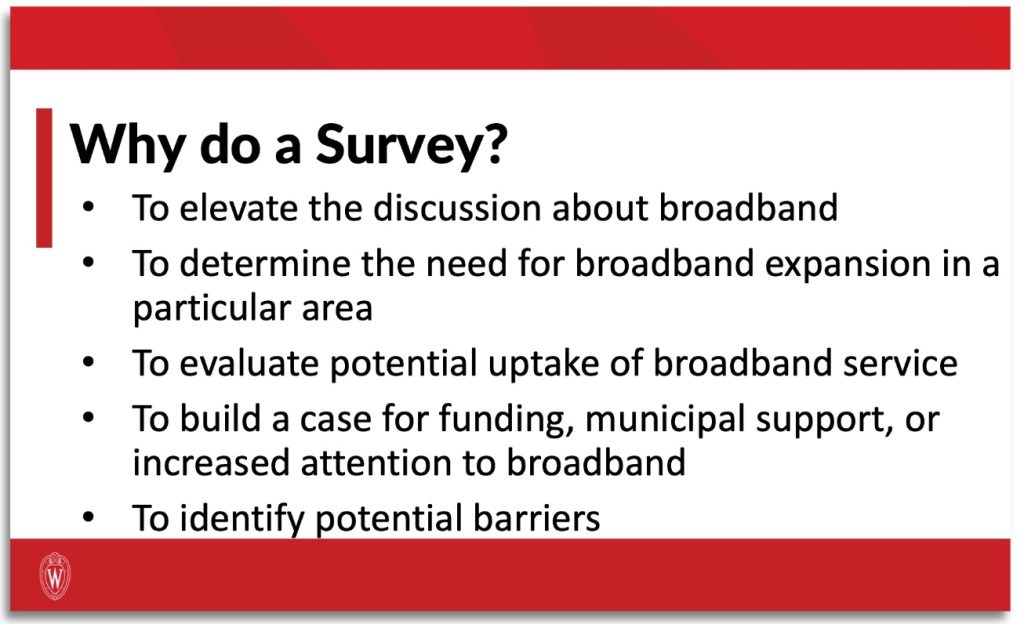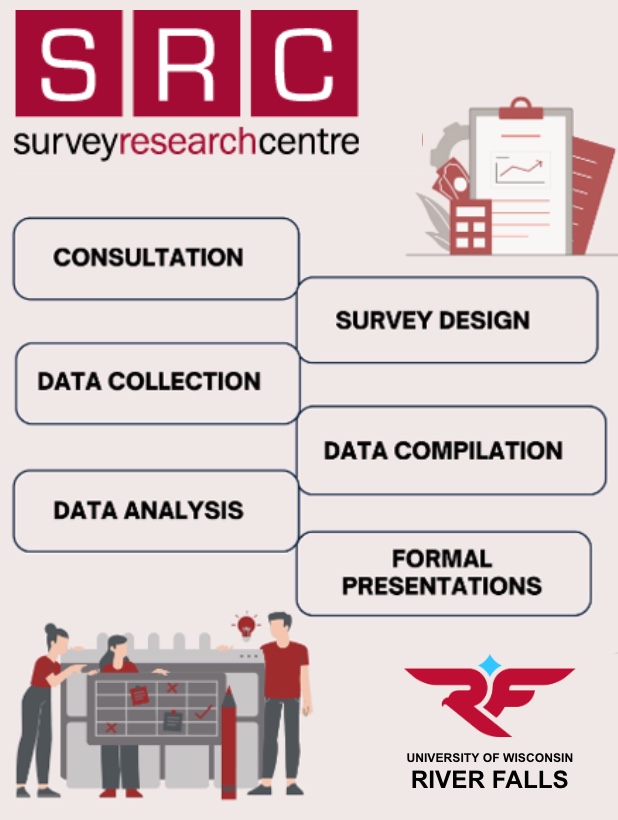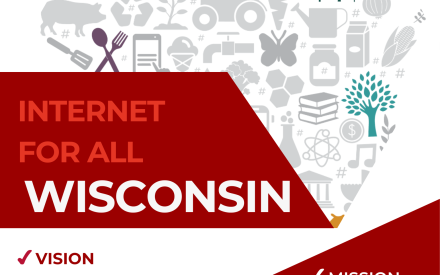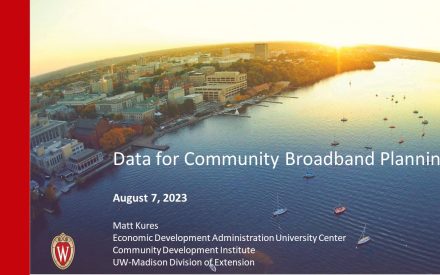In this article, we will discuss tools to inform broadband planning. Specifically, when and how to use surveys to gather input from the public in your broadband and digital equity planning and explore types of exploratory conversations to support broadband expansion opportunities in your communities.
Surveys
Objectives of Conducting a Survey
Conducting a survey can benefit a broadband committee or community leaders to learn more about existing broadband services, the need for broadband expansion, and potential barriers. To develop and conduct a survey, it is essential to identify (and articulate to the public) your objectives. Your objectives will also help determine what you ask in your survey and drive many details.

Benefits of Conducting a Survey
Several broader benefits come from conducting a survey that your community (& committee) may benefit from.

Survey Considerations
During this survey planning process, there are many variables to consider. Each consideration can impact others, so careful planning is critical.
- Purpose of the Survey: “What do you want to learn?” and “What are you going to do with the information once it’s gathered?”.
- Scale: “What is the area you want to be surveyed?” Is it the whole county? Is it a city, village, or town? Is it a larger region covering more than one county? Or is it more finite, like a specific neighborhood or subdivision?
- Population to be surveyed: For example, maybe it’s a large enough area, and funds are limited that you are looking to gather a statistically significant sample and not disseminate it to every address in that area. Or maybe you are considering surveying everyone in a large area, and it’s open access to anyone within that area? Or maybe it’s a concentrated area, and you are looking for a 100% response?
- Survey tool: Paper (manual), online, or hybrid
- In-house or contracted out: Are you using your own available resources to do all the work? Or do you need someone with knowledge in this area to do this process?
- Publicity and engagement: How will you inform people about the survey and why you are doing it? How will you promote it and get the word out? And who can assist you in spreading the word about the survey and what you are trying to achieve?
Survey Example: Iowa County

Purpose:
- Identify gaps in service (At the time, the maps overstated the extent of broadband availability).
- Demonstrate the need and value that people put on having good broadband.
- Identify how services are being used now and their goals for the future.
Use of data: We needed better data to suggest that there was a serious need for the County to put resources behind the Broadband expansion.
Findings: A total of 1350 responses were received from the survey, with the majority being submitted online. About 250 paper forms were also returned.
The survey revealed some interesting findings, including the fact that 92% of respondents considered the Internet extremely or very important. However, 43% of the respondents expressed dissatisfaction with their available internet services. Interestingly, 27% of the respondents were willing to pay between $81 and over $100 per month for improved internet services, as compared to 10% in 2017. Furthermore, 92% of the respondents expressed a willingness to pay a one-time installation fee, with 51% willing to pay from $250 to over $1000.
In addition, the survey revealed that 267 of the respondents had home-based businesses, while another 226 would like to start one in the future. Furthermore, 486 respondents would like to telecommute in the future, but over 15% were unable to do so due to poor or no internet access. There were also 14 pages of additional comments, with 594 respondents interested in helping in any way they could.
Survey Example: Dane County

Purpose: 1. Identify gaps in service;
2. Understand the sufficiency of service;
3. Understand barriers to broadband uptake.
Use of data:
The Task Force needed better data to make the case to the County Board that there was a serious need for the County to put resources behind the Broadband expansion.
Looking at other surveys to find examples of questions and formats that might work for your community is beneficial. Download the Dane County Broadband Survey below to see the example of the survey created by the Dane County Broadband Task Force.
Survey Resources
Consider what resources are available to assist you with your survey.

1. The Survey Research Center, UW-River Falls, is an excellent resource. They’ve already done Broadband surveys with many communities, so they have an in-house understanding of the issues. They welcome participation from the local entity in designing the survey. They will provide consultation services, mail out the survey, collect and compile the data, analyze it, and share results in a report and presentation.
2. Work with your local UW-Madison Extension educator. In some cases, the educator can assist with an in-house survey. If you decide to work with the Survey Research Center, there is a small discount available when they are approached by the Educator.
3. Regional Economic Development Organizations
Putting it Into Practice

Survey Considerations: Please download this worksheet to help you document all the survey considerations.
Conversations
“Creative agreements will be necessary to bring broadband to many of the state’s rural communities. It’s all about creating that collaboration and being proactive and thinking outside the box.”
Types of Conversations
There are many different types of conversations that you may have as you consider doing a survey; below are some examples of conversations that may be helpful.
• Educational Conversations: Everyone needs to get up to speed on the need (the public, your group of collaborators, your boards) and the potential (linking broadband to economic development/ public health/education). Understanding the potential funding sources and the technologies associated with broadband delivery will be essential.
• One-on-One and Group Conversation: Conversations with different communities and groups will be essential; for example, through different institutions (schools, health care, Chamber of Commerce) and businesses as well as with different demographics (older, younger). The Extension Downtown Market Analysis Toolbox includes some advice on developing questions for group conversations (such as focus groups).
• Brainstorming: This could be with your broadband committee, Community leaders, neighborhood representatives, or the group you gathered to begin the exploratory conversations with. So what is possible? Who are potential partners, what are some resources we could tap into, and what are their federal and state funding sources? etc. The choices regarding scale, population to be surveyed, etc., will help determine the types of conversations you may have.
• Grassroots / “Community” Champions: These can be individuals within a small group who can make a significant impact by taking the lead in bringing a broadband solution to their area. An excellent example is Green Leaf Glen, a subdivision comprising only 22 homes. The residents worked together and managed to convince an ISP to install fiber-to-the-home for every house in the subdivision. One woman in the community played a crucial role in spearheading the efforts, including collecting survey data, organizing meetings, and convincing each household to make a one-time payment of $2,500 to offset the installation costs for the ISP. These types of grassroots projects are often successful when a “community” champion emerges to drive them to completion.
Adapted from National Digital Education Extension Team (2022)











 Data and Community Engagement
Data and Community Engagement What's Next in Wisconsin Broadband, May 2025
What's Next in Wisconsin Broadband, May 2025


